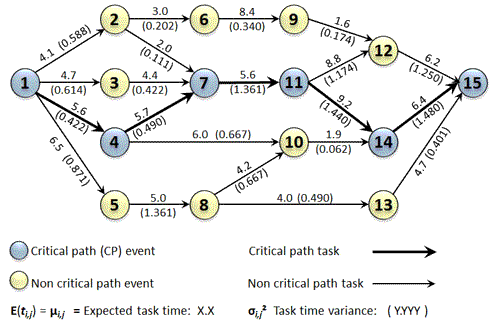Event, Activity and Critical Path are the terms commonly used in network planning methods for production planning of a production unit/ plant.
1. Event. The event is a specific instant of time which makes the start and the end of an activity. The event consumes neither time nor resources. It is represented by a circle and the event number is written within the circle, as shown in Fig. 16.1.

2. Activity. Every project consists of a number of job operations or tasks which are called activities. An activity is shown by an arrow and it begins and ends with an event. An activity consumes time and resources. An activity may be performed by an individual or a group of individuals.
The activity may be classified as critical activity, non-critical activity and dummy activity. The activity is called critical if its earliest start time (E S T) plus the time taken by it, is equal to the latest finishing time (L F T). A critical activity (e.g. A, C or E) is marked either by a thick arrow or by two lines as shown in Fig. 16.1.
The non-critical activities have provision (float or slack) so that, even if they consume a specified time over and above the estimated time, the project will not be delayed. In Fig. 16.1, B and D are non-critical activities.
When two activities start at the same instant of times (like activities C and D), the head events are jointed by a dotted arrow and this is known as dummy activity as shown by F in Fig. 16.1. The dummy activity does not consume time and resources.
3. Critical path. It is that sequence of activities which decide the total project duration. It is formed by critical activities. In Fig. 16.1, 1-2-4-5 is the critical path. A critical path consumes maximum resources. It is the longest path and consumes maximum time. A critical path has zero float or slack.
4. Slack or Float. The slack is with reference to an event and float is with respect to an activity. In other words, slack is used with PERT and float with C P M, but in general practice, they may be used interchangeably. The slack represents the difference between the earliest completion or finish time and the latest allowable time. The slack may be positive, negative or zero.
When the slack of an activity is positive, then it represents a situation where extra resources are available and the completion of project is not delayed.
When the slack of an activity is negative, then it represents that a program falls behind schedule and additional resources are required to complete the project in time.
When the slack of an activity is zero, then the activity is critical and any delay in its performance will delay the completion of whole project.


